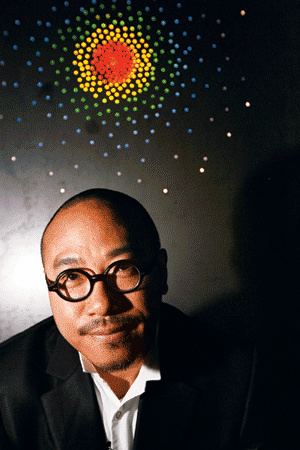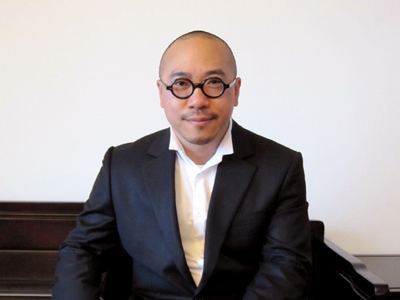Name Ho Kee | ||
 | ||
Education Department of Fine Arts, CUHK(1989)MFA degree in Sculpture from the Cranbrook Academy of Art(1995)Doctor of Fine Art degree from Royal Melbourne Institute of Technology(2003) Known for Performance Art, Installation Art, Sculpture Art Notable work Women and Blood Series (1993–1995)Love the Fucking Country (1997,2000)Ten Steps One Kneel to Xin Ya (1996, 2003, 2005) | ||
Trailer of aureola line by ho siu kee and chen kai
Ho Siu-Kee (何兆基) is a prestigious Hong Kong artist and visual art scholar who is well known in Hong Kong, China, Europe and the U.S.. Born in 1964 in Hong Kong. He appears as self-portraitures through the visual presentation of his own body imagery employing different media, such as sculpture, installation, photography and video. In 2012, Ho was selected as Associate Member of the Royal British Society of Sculptors.
Contents
- Trailer of aureola line by ho siu kee and chen kai
- live art daily ho siu kee
- Education
- Career
- Major works
- Installation
- Videos and photographs
- Sit Stand Lie
- References

live art daily ho siu kee
Education
Ho received a Bachelor of Fine Arts degree from the Chinese University of Hong Kong in 1989. Afterwards, he went to the United States and graduated with an MFA degree in Sculpture from the Cranbrook Academy of Art in 1995. In 2003, he received his Doctor of Fine Art degree from Royal Melbourne Institute of Technology (RMIT) University, Australia with the research topic of "Bodily Perception as a Means of Expression in Contemporary Art Practice".
Career
Apart from his artistic practice, Ho is also an art educator. He worked in Hong Kong Polytechnic University of the School of Design, from 1997 to 2000. In 2000, he joined the Hong Kong Arts Centre to help the establishment of its art education division namely Hong Kong Art School. Before teaching at Hong Kong Baptist University, Dr. Ho was the Academic Head of Hong Kong Art School.
Major works
Exploration of one's own senses and bodily perception is what Ho concern most. The visual presentation materializes and projects the innate personal experience as means of artistic expression which is expected to make up the communication between the "Self" and the "Other".
Installation
Ho works like a scientist in a laboratory, he elaborated a methodology of research and invented his own tools of experimentation. His "dream machines" remind Duchamp's ready-mades and Tinguely's machines à ne rien faire (useless), mainly because they look more like industrial products than pure aesthetic creations. Ho's constructions are rational artifacts invented to put his own body in situations of tension. The purpose of his persistent quest is to experience primordial perceptions at their phenomenological level.
"Walking on Two Balls" in 1995 was a way to feel the precarious balance of the first steps, or better, and to make the viewers aware of the complexity of what looks like the very simple act of walking. "The Third Eye" (1996), is an ingenious device to dismount the mechanism of vision, turning obvious the hidden, unconscious process that results in the act of seeing. With "Flying Machine" (1995-1996), and the "Sisyphus Chair" (1998), the myths of Greece are revisited by Ho to show how absurd are man’s attempts to go beyond the physical limits of his body. A series of works, “Gravity Hoop” in 1997, and “An Evolutionary Body” in 2000, illustrate in a very original way the scientific theories that explain the human body as a machine, constrained by the laws of the Universe.
Videos and photographs
Most of Ho's artworks begin with the exploration of his own senses and bodily perception and appear as self-portraitures through the visual presentation of his own body imagery employing different media, such as photography and video. The visual presentation materializes and projects the innate personal perceptual experience as a means of artistic expression which is expected to make up the communication between the "Self" and the "Others".
The appeal of artistic creation is not limited to the expressive and communicative function to be projected outwardly, it also includes the inwardly-directed self-reflection of the artist. The different forms and imagery of self-portraiture in a variety of individual works are like reflections in the mirror. The mirror image as an object perceived by myself causes the invisible self to become visible. It helps us to understand and to identity with the ‘Self’. Eventually, one can get along better with ‘Others’ in this phenomenal world and hopefully lead to a happier life.
Sit / Stand / Lie
Sit/ Stand Lie depicts the simple and basic postures of sitting, standing and lying down. When it is displayed you relate them to a cross, extending them into different rooms. It is one of the most favorite artwork of Ho Siu Kee, because it is the critical turning point of his creative development. Quoted from the interview, Hong Kong artist Kurt Chan Yuk-keung said, "I fully understand what you mean because I can see some development in its simplicity. It is like getting some taste from drinking some pure water."
